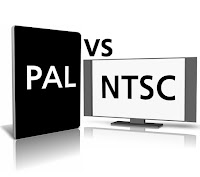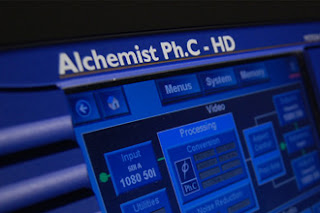 By Dan Parkes (Director/editor)
By Dan Parkes (Director/editor)
Formats can become a complicated issue in film production. Even when presented with opportunities to simplify and standardise formats (such as with the invention of DVDs and then HD) instead further complications were introduced. There are some good reasons for this -mostly due to regional differences in power supply and to prevent piracy and control pricing (i.e. DVD region codes).
PAL(25p) vs NTSC (30p)
PAL (Phase Alternating Line) is primarily a European/Australasian television format, or used where electricity supply is 50Hz. It now essentially refers to a frame rate of 25 or 50 frames per second . NTSC (National Television System Committee) on the other hand is primarily an American television format, or where electricity is 60Hz and refers to a frame rate of 29.97 or 60 frames per second. In the days before HD, PAL and NTSC also involved differences in vertical and horizontal resolution (PAL: 720x576, NTSC: 720x480), but thankfully that has been standardised, with HD resolution coming in at either 720p (1280x720) or 1080p (1920x1080). But the key difference in frame rates still remain, and the resolution difference does apply for DVDs. (Note: for reasons of simplicity this blog is referring to hard copy media such as discs, and not broadcast formats.)
Some considerations
So if you are purchasing or using equipment in a European country then you are most likely going to be shooting at 25p or 50p. In the US that will likely be either 29.97/30p or 60p. Even if you are filming at 24p (filmic) you will also eventually have to think about having it converted to either the European or US format. Generally speaking, most PAL DVD players in Europe will play a NTSC DVD. However it seems that very few NTSC DVD players can play a PAL disc. So you will eventually have to think of converting.
Conversion options
And this is where it can get really tricky for filmmakers, especially when thinking of submitting films for international festivals. There are two options you have for PAL-NTSC or NTSC-PAL conversion:
1.Conversion with a fixed running length
This method keeps the total length the same, but in order to do so, it has to interpolate (i.e. estimate frames that are between 2 original frames) or blur frames together via "frame blending" or "frame skipping". This maintains the same audio, but can be a slow process and more importantly, result in low quality output and unnatural motion.
2. Conversion with a fixed number of frames
This is what is referred to as ‘conforming'. You keep the same number of frames -they are just played at a slower/faster speed. However, this much better quality conversion also involves changing the speed of the audio. For example film conversion from 24p to PAL involves a 4% increase in speed, which raises the pitch by 0.7 of a semitone, something which is not normally noticeable and can also be 'pitch shifted' (restoring the original pitch).
There are both expensive and cheap (and nasty) options to achieve either of the above -at the top end you have the Snell & Wilcox Alchemist standards converter used by professional companies. At the other end of the scale you can try exporting it directly from your NLE in the desired frame rate -although this will likely be using the fixed running length conversion mentioned above in no.1, which is a low quality method.

Here are some other possible options:
- Use Adobe After Effects. Check this article on how to do it
- Try freeware/shareware programs such as TMPGEnc (http://www.tmpgenc.net) or VirtualDub (www.virtualdub.org)
- Pay for basic software such as DVFilm Atlantis ($45.00, http://dvfilm.com/atlantis/)
- Progressive/interlaced (if interlaced the field order can change i.e. "Upper Field First" or "Lower Field First").
- Changing the frame rate can cause the audio to become unsynchronised.
Please note: If you spot any errors or would like to add some extra advice for filmmakers, please feel free to comment below.






Exporting out from your NLE from one fps to another is just the plain bad way to do it. It might be cheap, but it looks awful because those fractional frames that NTSC use throw real spanners into the works.
ReplyDeleteSo far the only computer software i've come across that does it right, is Graham Nattress' plugins for FCP. These split your footage down to the field level and recombine at the rate fps rate, which incidentally is how the expensive hardware solutions work. I'll let you google him :)
The important thing is to know in advance of shooting exactly where you are marketing your product and plan accordingly. It seems to be easier to shoot at 24fps and convert upwards. My experience shooting at 25fps led to my going bald trying to get it to 29.97!
Thanks Richard. Very true. We have had similar headaches shooting at 24p for conversion to PAL! At the end of the day it seems best, as you say, to shoot in the format where you intend distributing. Personally I have found 'filmic' 24p to be a bit of an unnecessary holy grail for filmmakers, as from my time working in a cinema I came to understand that projectors have a rotating shutter meaning that 24p is in fact prohected at 48 on the silver screen (to help smooth motion!). But I can understand how it is a much easier workflow to shoot at 24fps as it converts well to 29.97.
ReplyDeleteOh dear - your intro does not bode well!
ReplyDeleteDVD Region code was intended to allow Hollywood to control release dates. You have not differentiated FRAMES and FIELDS, or indeed PROGRESSIVE & INTERLACED. PAL & NTSC are ANALOGUE formats that don't have a digital 'resolution'. 720 refers to the horizontal sample rate for DTV. The larger HDTV format is 1080i (interlace). You miss the vital point that DVD is of course Standard Def.
Cutting to the chase, After Effects can in fact perform several methods of standards conversion right up to the levels set by the Alchemist although in that case it requires third party 'plug-ins' and a very considerable level of driving skill. Using the 'Frame Blending' standard feature, AE standards conversion can be quite effective and reasonable quality.
Actually @Anonymous, the writer specifically excluded PAL/NTSC broadcast standards for simplicity, instead concentrating on DVD standards which are digital and have a defined resolution. Almost all DVDs from film sources (which is what this blog is about) in the last 10 years are progressive scan.
ReplyDeleteMy experience with this wretched task involved battling with JES Deinterlacer, a very powerful but free application that apparently can produce great results. However I found it had just too many configuration options for me to get the results I wanted.
In the end, I got a very good result converting from PAL to NTSC using Final Cut's Compressor, but you must enable frame controls to get the requisite fine tuning of motion. I subsequently found a very good article on Kenstone.net called "Converting Frame Rates in Compressor" which talks you through the process - wish I had found it at the start of my journey!
Thanks Robin and "Anonymous" for your comments.
ReplyDeleteJust to confirm, PAL<->NTSC is not just analogue but is in fact also a digital issue -although in HD it is about frame rates not resolution. For more information check this article:
http://hometheater.about.com/od/televisionbasics/qt/ntscpalframes.htm
I have updated the point about DVD regions to clarify that it is more to do with studio release dates i.e. pricing than piracy, although piracy is a factor.
As Robin points out the issues regarding interlace/fields are not relevant here...and hopefully things of the past!
@Anonymous -can you let us know exactly what plugins for AE give us Alchemist quality conversions?
@Robin Hislop -many thanks for the JES Deinterlacer and Kenstone.net article tips -most helpful I think.
Anyone else, please feel free to add comments and corrections on this sometimes difficult but important subject. However, unlike "Anonymous" please don't SHOUT, we are all friends here, trying to help each other out! :-)
Sorry about the 'shouting', just trying to make the point that these are actually specific definitions, not vague ideas. Robin says that interlace scan is not relevant then immediately talks about a 'Deinterlacer' utility!
ReplyDeleteUnfortunately the terms 'PAL' and 'NTSC' have now lost their true meaning and are used willy nilly to indicate almost anything to do with standards relating to different frame rates.
Getting a decent result converting (say) 50 frames/sec to 60 frames/sec is not too difficult but converting 25p to 24p is a wholly different ball park usually bypassed by running 'slow'.
I'm a few years out of practice with After Effects, but basically you need a motion interpolation filter like Twixtor. You are trying to create 6 frames from the original 5. The crudest systems simply repeat frames, better is to use frame blending, best is to work out where all the pixels would be in the new frame timings.
Even Alchemist makes mistakes! Many years ago I remember S&W said they were going to make software available for AE but I never saw it actually materialise!
Just had a quick Google and found this:
ReplyDeletehttp://www.videocopilot.net/tutorial/frame_rate_converter/
which is quite a nice video tutorial which mentions most of the issues concerned. I've not used the Andrew Kramer filter mentioned but seems to be similar to Twixtor.
Thanks "Anonymous" -the free Andrew Kramer plugin and tutorial is a good start for using After Effects to do the conversion. I have used it before and had some reasonable results but it certainly isn't perfect. But I think the most common complaint is the speed...
ReplyDelete@Anonymous: While JES Deinterlacer was originally written as a deinterlacer, and it is very good at it, it is also a very capable frame rate converter. Deinterlacing is a totally separate subject, and not relevant here.
ReplyDelete